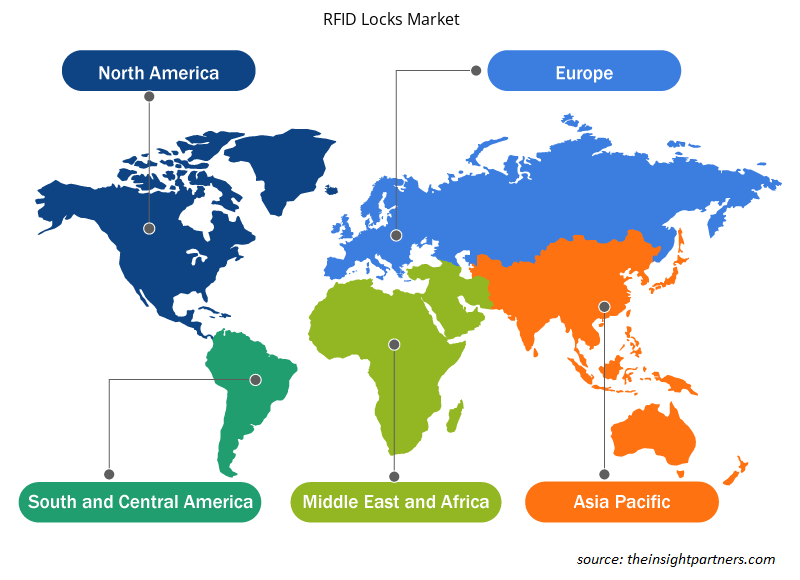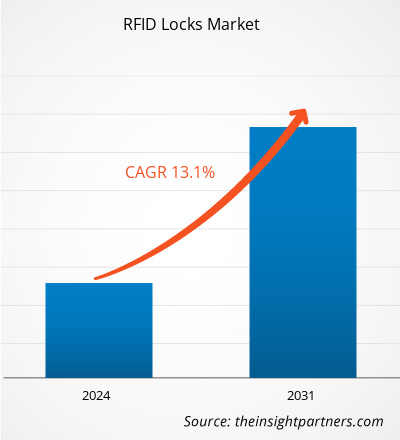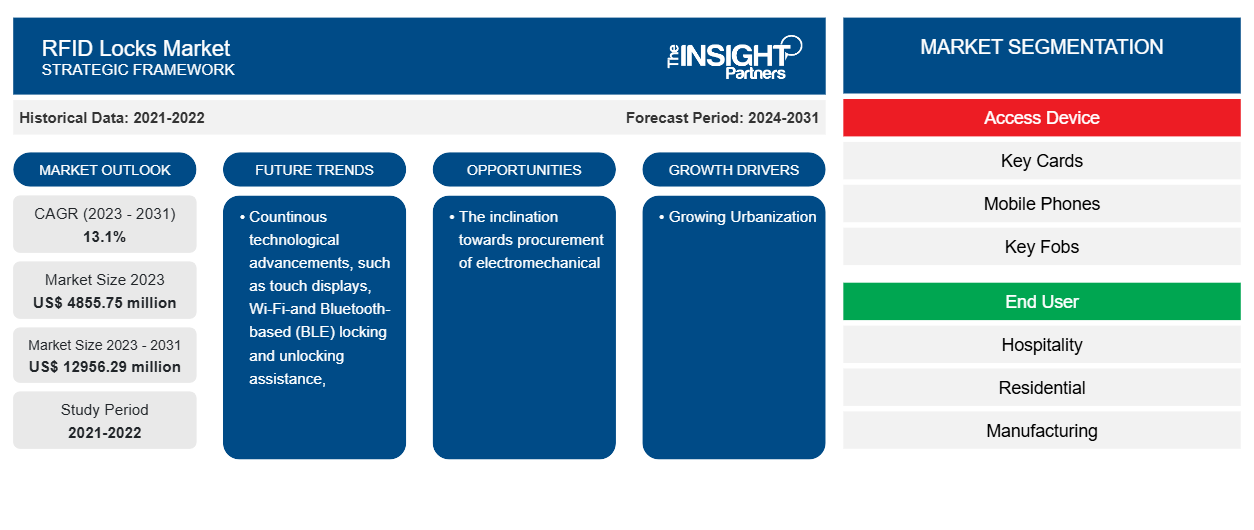Si prevede che la dimensione del mercato delle serrature RFID raggiungerà 12956,29 milioni di dollari entro il 2031 da 4855,75 milioni di dollari nel 2023. Si prevede che il mercato registrerà un CAGR del 13,1% nel 2023-2031. I continui progressi tecnologici, come i display touch, il blocco basato su Wi-Fi e Bluetooth (BLE) e l'assistenza allo sblocco, rimarranno probabilmente un sistema chiave per comprendere le tendenze del mercato.
Analisi di mercato delle serrature RFID
Vari fattori, in particolare l'espansione del settore alberghiero e turistico in tutto il mondo, stanno guidando la costruzione di nuove strutture commerciali, tra cui gli hotel. L'espansione delle chiuse REID è alimentata direttamente dai piani per costruire hotel con più stanze e da un aumento dei finanziamenti governativi a supporto del settore alberghiero, incoraggiando l'espansione del mercato. Uno dei fattori principali che guidano la domanda di soluzioni di accesso migliorate è l'urbanizzazione. La necessità di soluzioni infrastrutturali sempre più complesse e avanzate sta crescendo a causa dell'urbanizzazione che crea più conurbazioni e città con popolazioni di un milione o più. Questo fattore sta anche contribuendo in modo significativo all'espansione del mercato.
Panoramica RFID
Una serratura elettronica che utilizza una scheda a radiofrequenza come chiave è chiamata serratura RFID o serratura con tessera identificativa. La vecchia scheda contattabile necessitava del contatto fisico con un lettore per aprire una serratura; con l'uso della tecnologia RFID, la scheda RFID può farlo senza contatto. La tecnologia RFID utilizza onde elettromagnetiche per trasmettere segnali come parte del suo sistema di riconoscimento. Inoltre, a causa del suo concetto tradizionale e del costo elevato, il sistema di serratura RFID non viene utilizzato per sostituire le serrature meccaniche per uso domestico. Inoltre, le prestazioni in tempo reale delle serrature delle porte RFID possono essere sia positive che negative.
Personalizza questo report in base alle tue esigenze
Riceverai la personalizzazione gratuita di qualsiasi report, comprese parti di questo report, o analisi a livello nazionale, pacchetto dati Excel, oltre a usufruire di grandi offerte e sconti per start-up e università
-
Scopri le principali tendenze di mercato in questo rapporto.Questo campione GRATUITO includerà analisi di dati che spaziano dalle tendenze di mercato alle stime e alle previsioni.
Driver e opportunità RFID
Crescente urbanizzazione
La crescita della popolazione globale e l'aumento della migrazione dalle zone rurali a quelle urbane stanno determinando una tendenza al rialzo nell'urbanizzazione. Le nazioni meno sviluppate hanno tassi di aumento della popolazione urbana più lenti rispetto alle nazioni altamente sviluppate. Le persone che si spostano in cerca di nuovi lavori, case e spazi commerciali necessitano di sistemi di controllo degli accessi e di sicurezza negli edifici per tenere fuori i visitatori indesiderati. Sempre più residenze, uffici, hotel, magazzini e altri luoghi utilizzano sistemi di chiusura intelligenti. Inoltre, poiché non è più necessario portare con sé una chiave o ricordare una password, lo sviluppo di serrature digitali touchpad, serrature con impronte digitali , tessere REID e altre serrature intelligenti offre ai consumatori ancora più facilità. I settori residenziale e commerciale stanno chiaramente assistendo a un aumento delle soluzioni di sicurezza degli accessi.
La propensione all'acquisto di prodotti elettromeccanici rispetto ai tradizionali sistemi di chiusura
La preferenza per i prodotti elettromeccanici rispetto ai sistemi di chiusura convenzionali è aumentata notevolmente e si prevede che questa tendenza continuerà, offrendo agli utenti di sistemi di chiusura intelligenti una varietà di opzioni di crescita. Alcune delle caratteristiche offerte dal mercato delle serrature REID sono il design ergonomico, il design ben adattato, la conformità ADA, l'universalità e la flessibilità, che ne aumentano la popolarità nelle aziende, in particolare negli hotel. Molte case residenziali, appartamenti, scuole, piccoli edifici commerciali e altri luoghi simili hanno ancora le porte esterne e interne chiuse a chiave utilizzando le tradizionali serrature a chiave e a pomello. Le soluzioni di chiusura intelligenti stanno diventando più popolari tra i proprietari di aziende e proprietari di case a causa della crescente urbanizzazione e della maggiore domanda di sicurezza. Di conseguenza, per rendere le loro serrature elettroniche più intelligenti, i produttori di serrature stanno integrando la tecnologia intelligente in esse. Pertanto, si prevede che la propensione all'approvvigionamento di prodotti elettromeccanici rispetto ai sistemi di chiusura tradizionali presenterà nuove opportunità per gli operatori RFID durante il periodo di previsione.
Analisi della segmentazione del report RFID
I segmenti chiave che hanno contribuito alla derivazione dell'analisi RFID sono l'applicazione e gli utenti finali.
- In base al dispositivo di accesso, l'RFID è segmentato in key card, telefoni cellulari e portachiavi. Il segmento delle key card ha detenuto una quota di mercato maggiore nel 2023
In base all'utente finale, l'RFID è suddiviso in settori quali ospitalità, residenziale, produzione, vendita al dettaglio, automotive, aerospaziale e difesa, governo e servizi pubblici e altri.
Analisi della quota RFID per area geografica
L'ambito geografico del rapporto RFID è principalmente suddiviso in cinque regioni: Nord America, Asia Pacifico, Europa, Medio Oriente e Africa e Sud America/Sud e Centro America. Le tecnologie di sicurezza avanzate come le serrature per porte abilitate RFID e NFC stanno diventando sempre più note nella regione APAC, in particolare per le applicazioni di sicurezza domestica. Inoltre, le principali aziende stanno investendo in nazioni in via di sviluppo come Cina e Giappone, il che sta alimentando la necessità di soluzioni accessibili che facilitino un controllo efficace degli accessi . Durante il periodo di previsione, si prevede che il mercato della regione APAC aumenterà come risultato di questo investimento e dell'uso crescente di soluzioni di sicurezza avanzate.
Ambito del rapporto RFID
Notizie RFID e sviluppi recenti
L'RFID viene valutato raccogliendo dati qualitativi e quantitativi post-ricerca primaria e secondaria, che includono importanti pubblicazioni aziendali, dati di associazioni e database. Di seguito è riportato un elenco di sviluppi nel mercato dei disturbi del linguaggio e della parola e delle strategie:
- Ad agosto 2022, Kalahari Resorts & Conventions ha adottato la tecnologia RFID per le serrature delle porte e il sistema di gestione del controllo accessi Visionline di Assa Abloy Global Solutions. Con un semplice braccialetto RFID o una tessera magnetica, gli ospiti possono accedere alla propria camera, ad altri resort e acquistare articoli senza dover portare con sé carte di credito personali o contanti.
(Fonte: Kalahari Resorts & Conventions, comunicato stampa)
- Nel settembre 2021, Honeywell ha acquisito la società privata Performix Inc. L'acquisizione si basa sulla strategia di Honeywell volta a creare la piattaforma software integrata leader a livello mondiale per i clienti del settore delle scienze biologiche che si impegnano a raggiungere una conformità più rapida, una maggiore affidabilità e un volume di produzione più elevato.
(Fonte: Honeywell, Comunicato stampa)
Approfondimenti regionali sul mercato delle serrature RFID
Le tendenze regionali e i fattori che influenzano il mercato delle serrature RFID durante il periodo di previsione sono stati ampiamente spiegati dagli analisti di Insight Partners. Questa sezione discute anche i segmenti e la geografia del mercato delle serrature RFID in Nord America, Europa, Asia Pacifico, Medio Oriente e Africa e Sud e Centro America.

- Ottieni i dati specifici regionali per il mercato delle serrature RFID
Ambito del rapporto di mercato sulle serrature RFID
| Attributo del report | Dettagli |
|---|---|
| Dimensioni del mercato nel 2023 | 4855,75 milioni di dollari USA |
| Dimensioni del mercato entro il 2031 | 12956,29 milioni di dollari USA |
| CAGR globale (2023-2031) | 13,1% |
| Dati storici | 2021-2022 |
| Periodo di previsione | 2024-2031 |
| Segmenti coperti |
Per dispositivo di accesso
|
| Regioni e Paesi coperti |
America del Nord
|
| Leader di mercato e profili aziendali chiave |
|
Densità dei player del mercato delle serrature RFID: comprendere il suo impatto sulle dinamiche aziendali
Il mercato dei lucchetti RFID sta crescendo rapidamente, spinto dalla crescente domanda degli utenti finali dovuta a fattori quali l'evoluzione delle preferenze dei consumatori, i progressi tecnologici e una maggiore consapevolezza dei vantaggi del prodotto. Con l'aumento della domanda, le aziende stanno ampliando le loro offerte, innovando per soddisfare le esigenze dei consumatori e capitalizzando sulle tendenze emergenti, il che alimenta ulteriormente la crescita del mercato.
La densità degli operatori di mercato si riferisce alla distribuzione di aziende o società che operano in un particolare mercato o settore. Indica quanti concorrenti (operatori di mercato) sono presenti in un dato spazio di mercato in relazione alle sue dimensioni o al valore di mercato totale.
Le principali aziende che operano nel mercato delle serrature RFID sono:
- Assa Abloy AB
- Società Bai Fu Ltd.
- Blocco digitale (Security People Inc.)
- Gruppo Dormakaba
- Euro-locks SA NV (gruppo Lowe e Fletcher)
- Azienda manifatturiera Godrej and Boyce Ltd.
Disclaimer : le aziende elencate sopra non sono classificate secondo un ordine particolare.

- Ottieni una panoramica dei principali attori del mercato delle serrature RFID
Copertura e risultati del rapporto sul mercato delle serrature RFID
Il rapporto "Dimensioni e previsioni del mercato delle serrature RFID (2021-2031)" fornisce un'analisi dettagliata del mercato che copre le seguenti aree:
- Dimensioni e previsioni del mercato a livello globale, regionale e nazionale per tutti i segmenti di mercato chiave coperti dall'ambito
- Dinamiche di mercato come fattori trainanti, vincoli e opportunità chiave
- Principali tendenze future
- Analisi dettagliata delle cinque forze PEST/Porter e SWOT
- Analisi di mercato globale e regionale che copre le principali tendenze di mercato, i principali attori, le normative e gli sviluppi recenti del mercato
- Analisi del panorama industriale e della concorrenza che copre la concentrazione del mercato, l'analisi della mappa di calore, i principali attori e gli sviluppi recenti
- Profili aziendali dettagliati
- Analisi storica (2 anni), anno base, previsione (7 anni) con CAGR
- Analisi PEST e SWOT
- Valore/volume delle dimensioni del mercato - Globale, Regionale, Nazionale
- Industria e panorama competitivo
- Set di dati Excel
Report recenti
Rapporti correlati
Testimonianze
Motivo dell'acquisto
- Processo decisionale informato
- Comprensione delle dinamiche di mercato
- Analisi competitiva
- Analisi dei clienti
- Previsioni di mercato
- Mitigazione del rischio
- Pianificazione strategica
- Giustificazione degli investimenti
- Identificazione dei mercati emergenti
- Miglioramento delle strategie di marketing
- Aumento dell'efficienza operativa
- Allineamento alle tendenze normative























 Ottieni un campione gratuito per - Mercato delle serrature RFID
Ottieni un campione gratuito per - Mercato delle serrature RFID